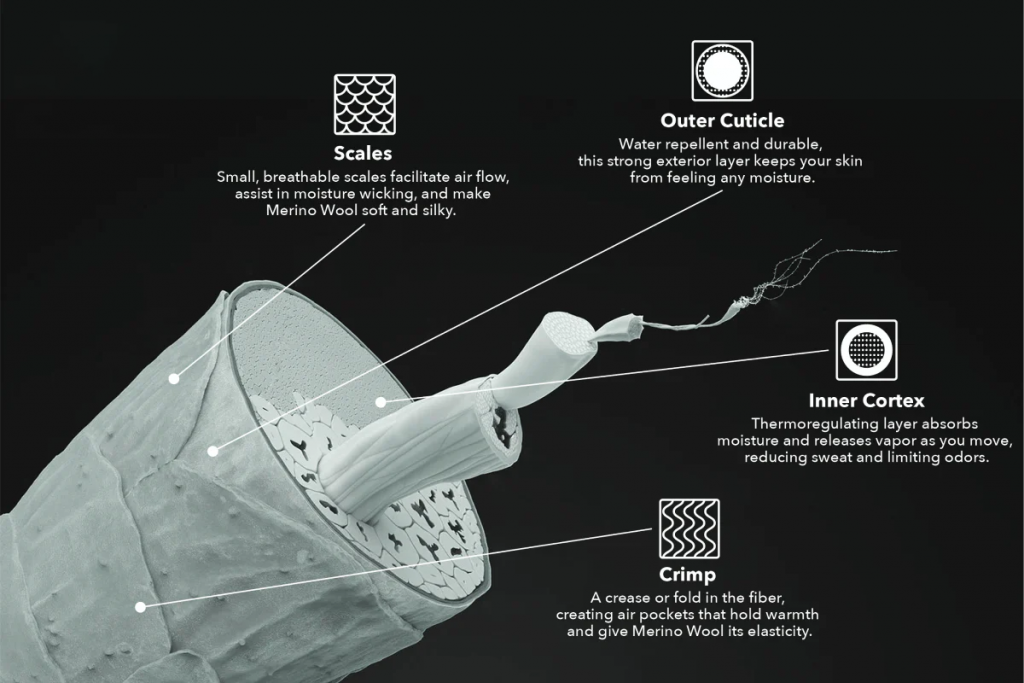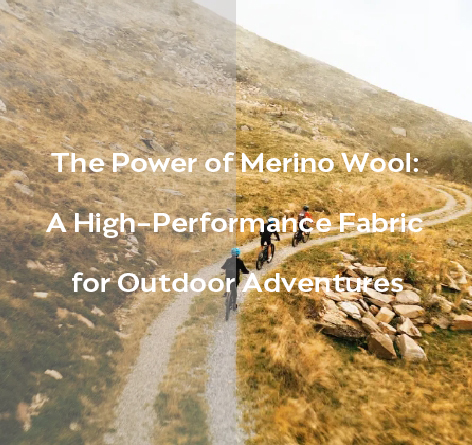When temperatures decrease, the base layer can have a significant effect, whether you’re on the mountains, heading to the outdoors, or simply staying at home. Merino wool thermal’s popularity is due to its ability to solve a problem for both cold and mild climates. Developed from the finest natural fibers of wool, they possess exceptional temperature regulation, moisture-wicking abilities, and odor resistance, all of which are ideal for active lifestyles, travel, and everyday wear.
In this article, we’ll discuss all of the information you need to know about the Merino wool thermal. From the benefits they offer and the ideal uses they have to care tips and comparisons to synthetic alternatives, this article will assist you in determining if they are the proper fit for your Wardrobe.
Ⅰ. Why Select Merino wool?
When selecting the proper fabric for warmth, Merino wool is typically the first choice for both recreational and everyday use. This extraordinary natural fiber is recognized for its exceptional attributes that make it a popular choice. Let’s discuss the primary advantages of Merino wool that distinguish it from other substances.
1. Gentle and Itch-free
One of the most beneficial aspects of Merino wool is its small fiber diameter, which is typically between 13.5 and 18 microns. This causes the wool to become more fleshy and less irritating to the skin than traditional wool, which can often cause itchiness. Many individuals, including those with sensitive skin, find Merino wool textiles extremely inviting to wear directly against their anatomy. The company The Woolmark describes this softness as the reason why merino wool is ideal for both recreational activities and everyday wear.
2. Moisture-Wicking Capacity
Merino’s wool is naturally moisture-wicking, which means that it effectively conveys moisture away from your skin. When you sweat, the fibers are affected by the moisture, which is then transferred to the air. This maintains your skin’s moisture and comfort during physical exercise, whether it’s hiking in the mountains or simply walking around your day. The moisture-wicking properties facilitate the regulation of your body temperature, this property is beneficial in diverse environments.
3. Odor-Resistant
Merino wool is inherently odor-resistant, this is an important attribute to those who participate in daily activities that require a lot of effort. The unique composition of wool prevents the accumulation of bacteria that cause odor, this allows you to wear Merino wool without having to wash it. This is beneficial to travelers or enthusiasts who may not have access to a laundromat. Studies have demonstrated that merino wool is able to maintain its freshness over time, making it a great choice for long travel.
4. Breathability and insulation
Merino wool’s capacity to breathe is well-known, this allows for the circulation of air while also providing insulation. This peculiar combination promotes a comfortable experience in both cold and warm climates. The fibers harbor heat without overheating the body, this keeps you warm during cold days with temperatures that rise. This versatility is beneficial because you can wear Merino wool thermal pants in a variety of activities and conditions.
Ⅱ. How Merino Wool Thermals Excel in Outdoor and Everyday Use
Merino wool thermals have been associated with a variety of versatile and effective scenarios, making them a popular choice for both everyday wearers and outdoor enthusiasts. Here is how these exceptional thermal’s specialize in different circumstances:
1. Sports
When participating in sports that involve wintertime activities, such as skiing, snowboarding, or hiking in cold conditions, Merino wool thermal pants are a great first layer choice. They provide warmth without bulk, which is essential for moving around on slopes or paths. The moisture-wicking properties of the fabric facilitate evaporation of sweat from your skin, this decreases the likelihood of chilling as you cool down following a strenuous activity.
2. Travel

Merino wool thermal pants are beneficial to travelers due to their lightweight composition and superior packability. They occupy little space in your luggage and can be reused multiple times without need to wash them, their odor-resistant properties allow them to be worn out multiple times. This causes them to be an ideal choice for long trips that lack a laundromat. Whether you’re traversing the chaotic airports or traveling to a new locale, Merino wool promotes comfort and style.
3. Daily Wear
Other than outdoor adventures, Merino wool’s unique properties allow it to seamlessly integrate into everyday wear. They can be dressed up as part of everyday outfits or incorporated into formal attire during more temperate seasons. The breathability of Merino wool enables you to remain comfortable all day; this makes it appropriate for a variety of environments, including office settings and weekend trips. Additionally, their slim design makes them appear discrete under other clothing, which provides warmth without sacrificing style.
Ⅲ. How to Wash and Maintain Merino Wool Thermals

To maintain your Merino’s wool, you must take care and preserve it. Other than conventional wool, merino wool is more malleable and can be machine-washed, however, there is specific advice that must be followed in order to maintain its quality and capabilities.
1. machine-washable
Many of the Merino wool thermal’s are machine-washable, which makes them simple to use on a daily basis. However, it’s important to check the label of care for specific rules, some brands may have unique suggestions. Typically, a mild cycle with cold water will promote the fabric’s survival.
For more specific instructions on how to wash wool, see Woolmark company’s care guide.
2. Avoiding Shrinking
Merino wool is cherished for its softness and capabilities, but improper treatment can lead to shrinkage, which can adversely affect the fit and comfort of your thermal. Here is a list of essential strategies that will prevent this from happening.
- Cold Water Cleaning: Always clean Merino wool clothing in cold water. Hot water can cause the fibers to shorten, which results in shrinking. A cold water bath is more lenient on the fabric and effective at removing dirt and odors.
- Gentle Cycle: Use the gentle cycle on your washing machine to minimize motion, this can contribute to the felting of the wool fibers- this process causes the wool to shrink and become clustered together.
- Avoiding fabric softeners: It’s best to avoid using fabric softeners, as they will cover the wool’s fibers and affect their natural properties. Instead, choose a mild, wool-specific detergent that will maintain the quality of Merino wool.
- Air Drying: After cleaning, avoid the dryer, as the heat from the garments can greatly reduce their size. Instead, air-dry your thermals by placing them on a flat surface that is clean and dry in order to maintain their shape and prevent stretching or shrinking.
- Storing Properly: When not in use, store your Merino wool thermal in a cool, dry space. Avoid compacting or folding them into a drawer, this can lead to unwanted shrinking and stretching.
By following these protocols, you can greatly reduce the likelihood of shrinking and maintain your Merino wool’s appearance and fit for years.
For further advice on caring methods, see the HD‘s guide to wool care.
3. How Often to Wash?
One of the most significant advantages of Merino wool is its ability to naturally regulate the odor. Because of its unique fiber composition, merino wool is resistant to the development of bacteria that cause odor, this means that your thermals will not need to be washed as often as synthetic fibers. Many instances, you can wear them multiple times before requiring to launder them, this is especially beneficial to travelers and enthusiasts who enjoy outdoors.
Ⅳ. Merino Wool vs. Synthetic Thermals: Which One is Better?
When choosing thermal clothing, it’s important to contrast the Merino wool fabric with synthetic fibers in order to understand their respective benefits and limitations. This comparison is of great importance today because consumers have access to a variety of thermal options that must fulfill both performance requirements and personal preferences regarding comfort, sustainability, and environmental impact. By studying these factors, you can more effectively decide on a more personalized basis according to your specific activities and lifestyle.
1. Warmth and insulation
One of the most notable attributes of Merino wool is its exceptional warmth and insulation. Merino fibers produce small air chambers that regulate the temperature, this is accomplished by providing a good amount of control over the humidity. This implies that Merino’s thermal properties promote warmth in cold conditions while also having the breathability to pull away moisture when temperatures increase. According to Woolmark, Merino wool has both insulating and temperature-regulating properties, which makes it ideal for the changing climate.
Conversely, synthetic textiles, which are typically composed of polyester or nylon, can store heat but do not have the same level of breathability as natural fibers. While they are intended to be moisture-wicking, they can occasionally pick up sweat against their skin, which can lead to discomfort during high-intensity activities.
2. Durability
When considering the long term, both Merino wool and synthetic fibers have benefits and downsides. Merino wool is typically maintained for many years if cared for properly, this is because it is naturally resistant to wrinkles and smells. However, it is susceptible to be susceptible to moths and damage caused by improper handling.
Conversely, synthetic thermals are typically more durable regarding wear and tear and are less susceptible to environmental damage. However, they may become disfigured or lose their moisture-wicking abilities over time, this is especially true after multiple washes.
3. Environmental Impact

Many consumers have a significant concern about the environmental effect of their clothing decisions. Merino wool is environmentally friendly and biodegradable, the source of its supply is annual shearing of sheep. When discarded, wool typically decomposes, which naturally returns nutrients to the soil. This promotes its environmental friendliness to environmentally concerned shoppers.
Conversely, synthetic materials are derived from petrochemicals, which has led to concerns about their environmental impact. While some companies are attempting to implement recycling programs and create synthetic fibers that are recycled, these still contribute to the microplastic pollution of water systems.
Ⅴ. Sustainability and Ethical Sourcing of Merino Wool

As consumers have become more aware of their environmental impact, the importance of environmentally friendly clothing options has increased significantly. The Merino breed’s wool is not only notable for its capabilities, but it is also dedicated to environmentally conscious living. Here are some of the main aspects that describe the sustainability and ethical procurement of Merino wool:
1. Non-Mulesed Wool
One of the most important factors in the ethical procurement of Merino wool is the utilization of non-mulesed fibers. Mulesing is a controversial procedure that involves removing skin from the hindquarters of sheep in order to prevent flystrike, a painful condition. Non-mulesed wool comes from farms that follow more humane protocols, they ensure that sheep are treated with care and respect. Many brands advocate for sourcing from suppliers that follow these ethical rules; this will support the animal welfare of mulesing and the benefits of non-mulesed wool; you can read this article from The Woolmark Company.
2. Biocyclic material
Merino wool is biodegradable, which means that it will naturally decompose when removed, this will return nutrients to the soil and will minimize the impact of landfills. Unlike synthetic fibers, which can take hundreds of years to decompose, the organic nature of merino wool allows it to have a positive impact on the environment even after it’s been used as a garment. This prns concords with the increasing popularity of sustainable fashion, as more consumers seek out clothing that has a minimal impact on the environment.
3. Recyclable Resource
Merino wool is derived from sheep that are annually shorn, this makes it a resource that is renewable. Every year, sheep’s new wool is produced by the same amount, without the need for intensive resource extraction, this is often associated with synthetic fibers derived from renewable sources. This sustainable approach to farming not only promotes environmental conservation, but also supports local economies by creating new jobs in the wool industry.
4. Carbon
Studies have demonstrated that the production of wool has a lower carbon footprint than does synthetic fiber. A research study by Wool UK suggests that sheep farming has a balanced effect on the carbon cycle, with the release of methane from sheep being part of the natural process. By wearing Merino wool, they can reduce the overall environmental impact of their clothing while still enjoying the superiority of the fabric.
Selecting Merino wool thermals is an example of taking a step towards more sustainable and ethical fashion. Practices like purchasing non-woody fabric, ensuring its biodegradability, and promoting renewable resources are all examples of how to live environmentally. As you consider your clothing options, consider the positive impact that environmentally friendly materials have on the planet.
Ⅵ. Conclusion
Overall, merino wool textiles offer a superior combination of warmth, versatility, and sustainability that is ideal for adding to any wardrobe. With their soft, itch-free composition, these garments offer unparalleled relaxation, allowing you to wear them for a long period of time without complaint. The intrinsic moisture-wicking and odor-resisting capabilities of merino wool result in you being able to remain fresh and dry during both recreational activities and natural outbreaks.
With all of these benefits, it’s smart to invest in merino wool thermals from our HD Merino lineup. Explore our diverse range of high quality products here and consider making merino wool a part of your clothing regimen— your comfort, style, and the planet will appreciate you.







